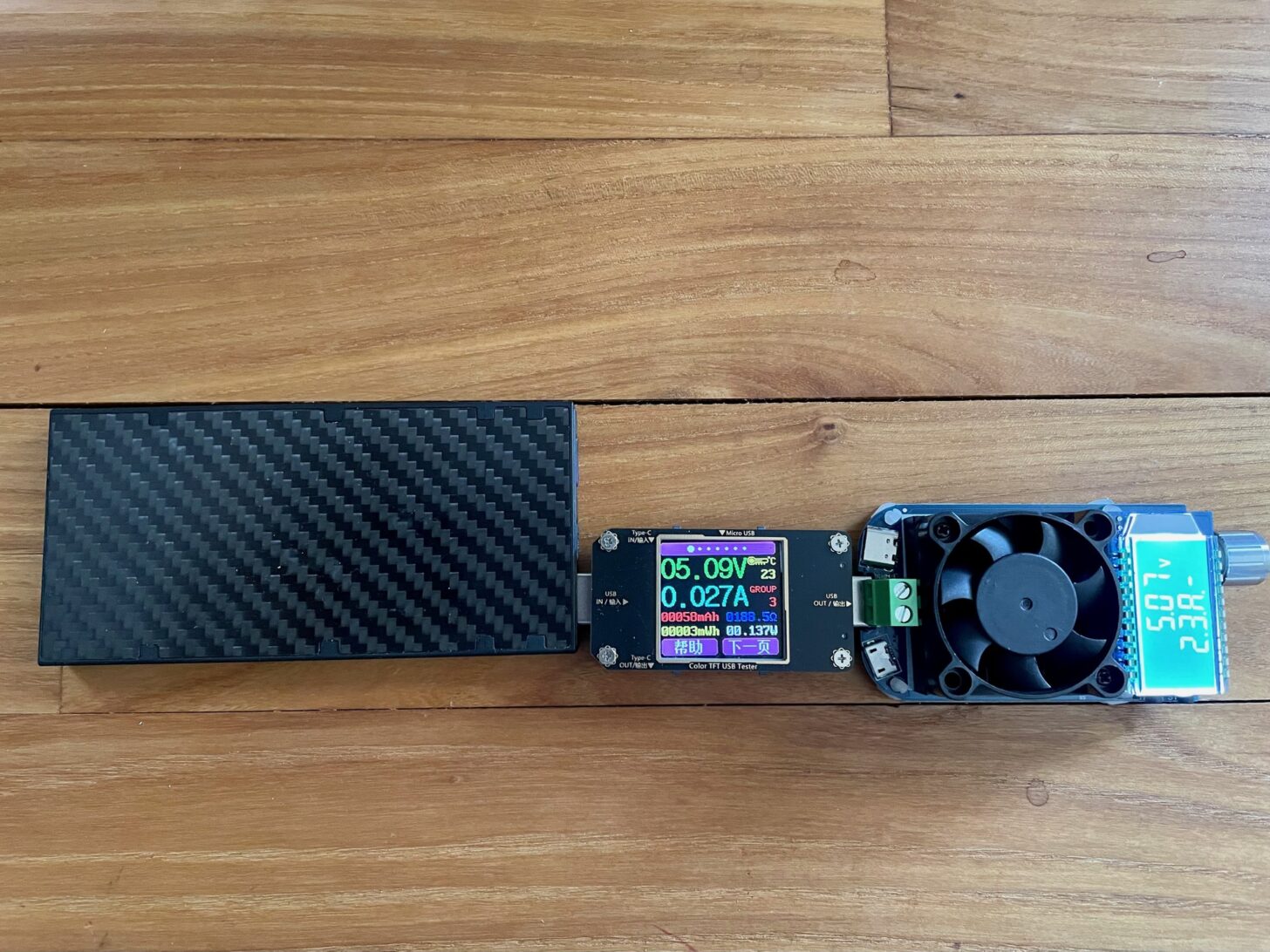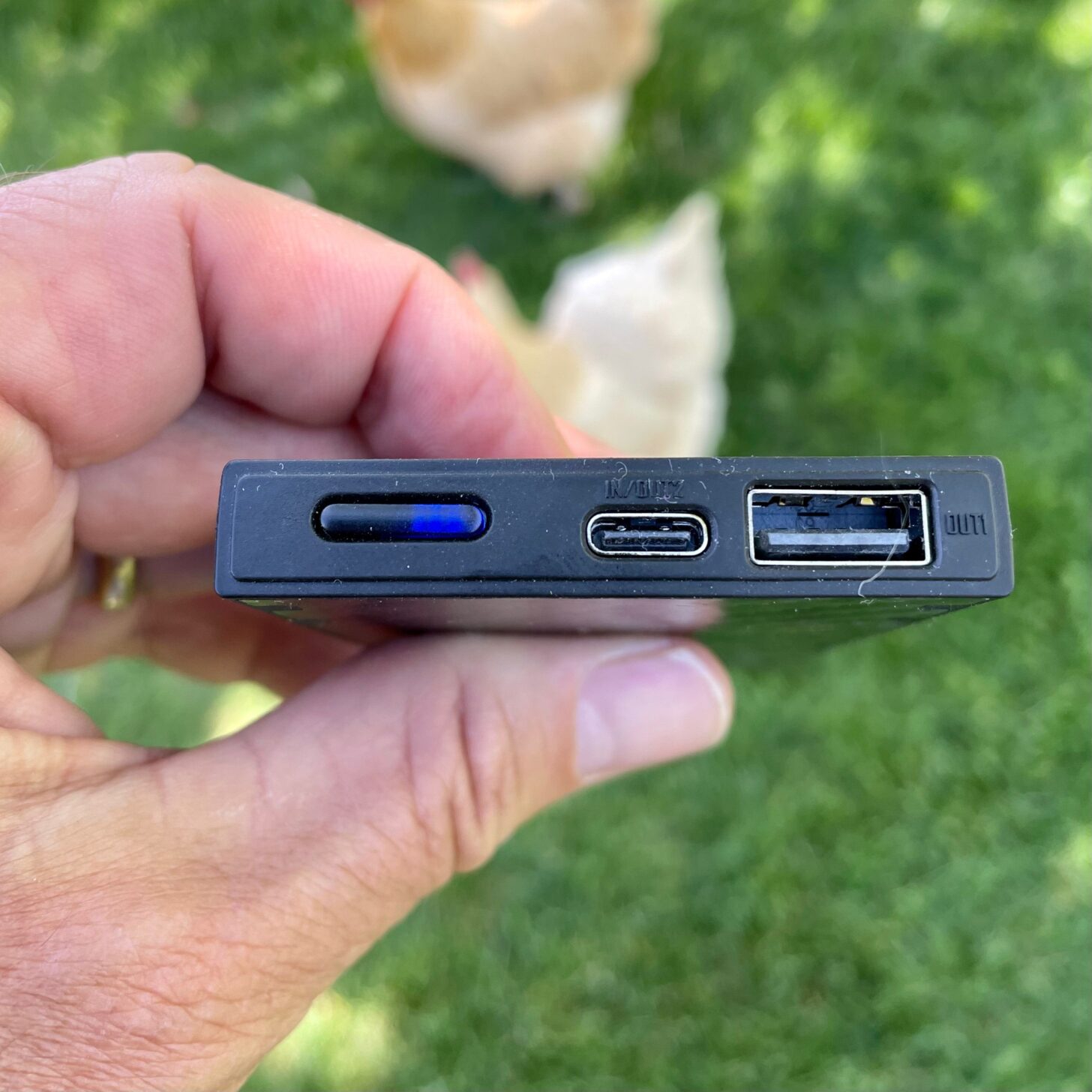Introduction
This Nitecore NB10000 review (5.3 oz / 150 g, MSRP $59.95) covers a lightweight entry into a crowded portable battery charger market. The Nitecore NB10000 features 10,000 mAh of nominal capacity at full charge, carbon fiber frame and panels, USB-A and USB-C outputs, a single multi-functional button, blue and white LED indicators, and pass-through charging capability.
The outstanding feature of this power bank is its high capacity-to-weight ratio. For a weight that is little more than that of a typical 5,000 mAh battery pack, you get twice the power. That’s an attractive proposition for any backpacker who carries electronics on multiday trips. I put the NB10000 through its paces at home and in the field to see if it delivers on its promise.

Watch Video: See our Member Q&A How to Manage Electronics and Batteries in the Backcountry.
Highlights
• 10,000 mAh at 3.85 V (38.5 Wh) nominal capacity
• 5.3 oz / 150 g
• 4.8 x 2.3 x 0.4 inches (12 x 5.8 x 1.0 cm)
• input: USB-C – 5 V @ 2.4 A (12 W) / 9 V @ 2 A (18W)
• output 1: USB-C – 5V @ 3 A (15 W) / 9 V @ 2 A (18 W) / 12 V @ 1.5 A (18 W)
• output 2: USB-A – 5 V @ 3 A (15 W ) / 9 V @ 2 A (18 W) / 12 V @ 1.5 A (18 W)
• carbon fiber frame and panels
• 3-level LED indicator for remaining power and charging status
• one-touch low current mode
• USB-A to USB-C cable included
• IPX5 rated (water resistant against sustained, low pressure water spray, dust protection not rated)
• operating temperature: 14 to 104 °F (-10 to 40 °C)
• storage temperature: -4 to 140 °F (-20 to 60 °C)
Testing context
I ordered the Nitecore NB10000 from Nitecore through Garage Grown Gear in February 2022. I performed quantitative testing at my home under typical indoor ambient conditions unless otherwise specified. I mostly followed the testing rubric described by Rex Sanders in BatteryBench: A Protocol for Testing Portable Battery Chargers and Electronic Devices for Backpacking. Rex’s fine article defines all the terms used here; if any are unfamiliar, please follow the link above.
I ran tests using the MakerHawk model QC2.0/3.0/4.0 MTK USB multimeter. For a load tester, I used the UCTRONICS Electronic USB Load Tester. The multimeter looks much the same as the one Rex used, but I found that I could not power the meter independently of the current being tested. My measurements, therefore, include some loss due to the power needed to operate the meter. The LED screen shuts off after 30 seconds, so I expect the power loss at the meter is only a few percent. The result is that my measurements of power delivered are low by a few percent.

For the energy loss measurements, I measured the power needed to fully recharge the phone, rather than the power remaining in the phone, as Rex did. My rationale is that when little power is lost, comparing small differences between large numbers is unreliable.
I also skipped the drop test, as I bought this item with my own money and didn’t want to risk breaking it, even in the name of science.
Editor’s Note: It’s worth mentioning that in yet-to-be-published research conducted by Rex Sanders, this product performed poorly in the drop test. Rex’s thoughts – “Good battery. Just don’t drop it.”
Field testing was performed on a week-long section hike of the Desert Trail between Halloran Summit on I-15 and Badwater in Death Valley, in March and April, 2022. Conditions were generally dry and windy, with temperatures of 35 to 100 °F (2 to 38 °C).
First impressions
Physical attributes and feature set
The Nitecore NB10000 is light. And small. Smaller than a typical phone. The measured size and weight agree with the manufacturer’s specs.

The design is minimalist. There are just the two ports and a level indicator panel that also serves as an on-off/change-mode switch. There is no flashlight or any other functionality. All corners are squared, not rounded or otherwise streamlined.

Construction and quality
The carbon-fiber panels are pressed onto the carbon-fiber frame, aligned and held in place by four tabs on each edge. The fit of the panels is tight and even, but not invisible. The ports feel stable and solid when plugging and unplugging cables. The power button feels solid when pressing it. I own one other Nitecore product, a USB-rechargeable headlamp, and it has functioned flawlessly for several years now. This battery pack appears to be made to the same level of quality.
In the Forums: See what the Backpacking Light community has to say about batteries and electronics.
Test results
The essentials
The parameters most important to hikers are:
- getting the most delivered energy for the least weight,
- and recharge time.
Delivered Energy – This is the amount of power that a battery pack can actually deliver to your small devices. I measured the output of the Nitecore at 29.6 Wh (@ 5 V x 3 A) or 5920 mAh. You’ll note that this is about 60% of the capacity specification. Capacity is how much energy is in the battery. Delivered energy is how much energy actually is available to the device being charged.
Member Exclusive
A Premium or Unlimited Membership* is required to view the rest of this article.
* A Basic Membership is required to view Member Q&A events




Home › Forums › Nitecore NB10000 Review